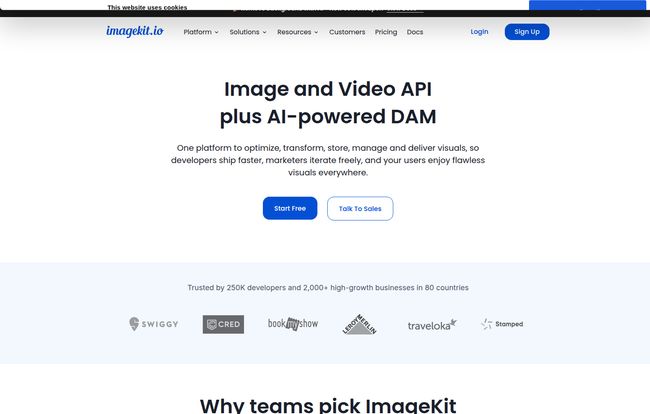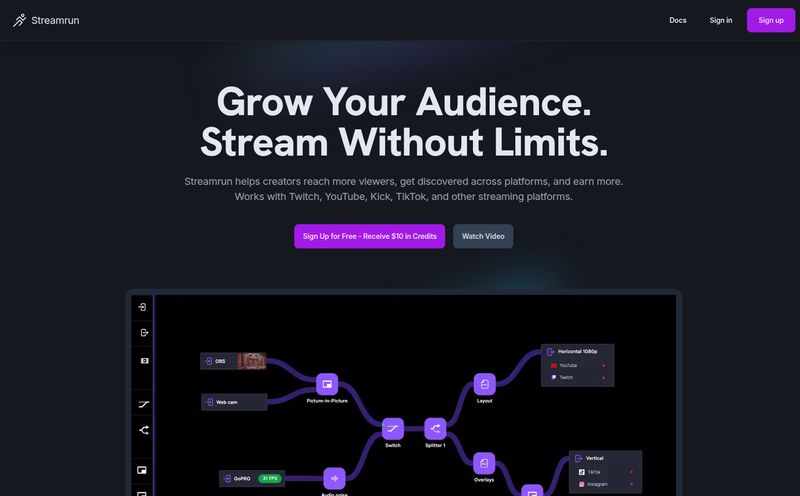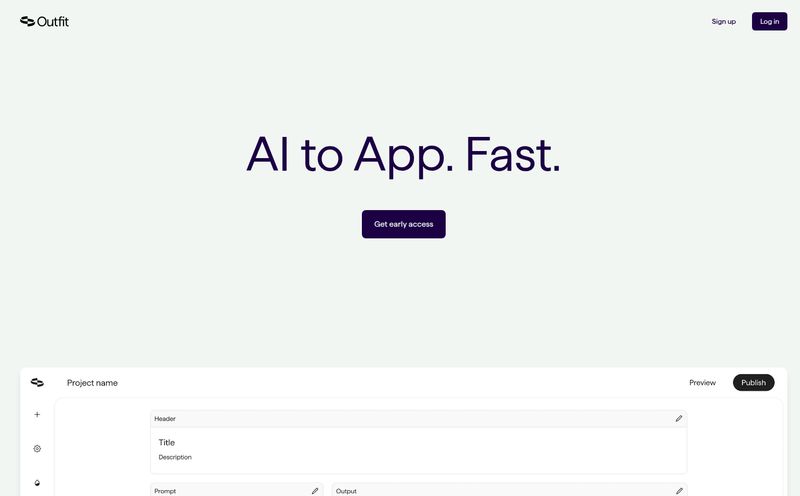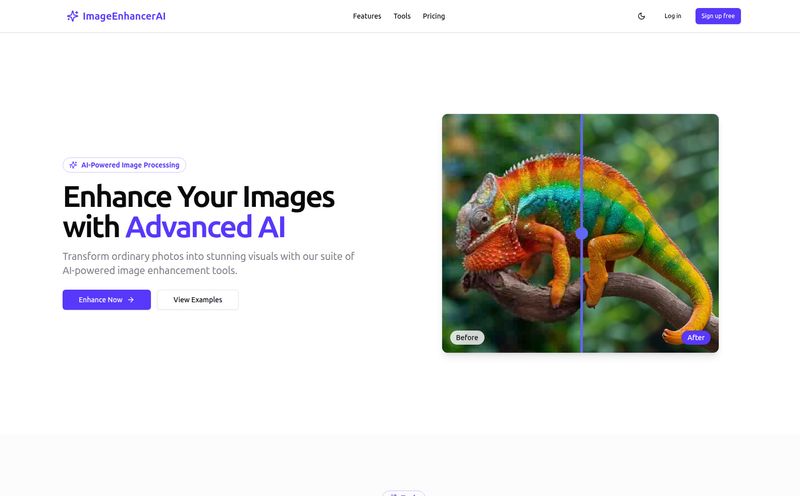If you’ve been in the SEO or web dev game for more than five minutes, you’ve felt the pain of media management. It’s this constant, slow-burning headache. Developers are pulling their hair out over performance budgets, marketers are screaming for high-quality visuals for yesterday's campaign, and somewhere in the middle is a Dropbox folder so chaotic it looks like a digital bomb went off.
We’re always chasing faster load times. We obsess over Google's Core Web Vitals, knowing that a few hundred milliseconds can be the difference between a conversion and a bounce. And images… images are usually the heaviest, clunkiest culprits.
So when another tool slides across my desk promising to solve all of this, my default setting is skepticism. I've seen a million of 'em. But ImageKit.io felt a little different from the jump. It wasn't just another CDN or a clunky asset manager. It presented itself as a unified solution. So, I rolled up my sleeves and decided to see if it was just clever marketing or the real deal.
What in the World is ImageKit, Anyway?
Okay, cutting through the jargon. At its heart, ImageKit is a real-time media processing API with a built-in, AI-powered Digital Asset Management (DAM) system.
Woah, that's a mouthful.
Think of it like this: ImageKit is the brilliant, hyper-organized quartermaster for your website's entire army of assets. It takes your big, beautiful, high-resolution images and videos, stores them (or just works with your existing storage), and then delivers them to your users in the perfect size, format, and quality at lightning speed. All on the fly. It's part CDN, part Photoshop-on-demand, and part super-smart media library, all accessible through one clean API.
It’s designed to be the peacekeeper between your tech, marketing, and creative teams. A single source of truth for every visual on your site.
The Core Features That Actually Move the Needle
A features list is just a features list until you see how it actually helps. Here’s the stuff that genuinely stood out to me.
One API for Both Images and Videos
This is bigger than it sounds. For years, we’ve had to stitch together different services—one for image delivery, another for video streaming. It's a mess of different bills, different APIs, and different workflows. ImageKit unifies this. You get one consistent way to handle all your visual media, which is a massive win for development simplicity and sanity.
Automatic Optimization is a Gift from the SEO Gods
This is where my ears really perked up. ImageKit automatically handles the heavy lifting for performance. It intelligently determines the user's browser and device, then delivers the image in the most efficient format, like AVIF or WebP, without you having to do a thing. It also compresses images to the best quality-to-size ratio. This is the kind of stuff that directly impacts your Largest Contentful Paint (LCP) score and makes Google happy. It’s like having a performance engineer working for you 24/7, for free.

Visit ImageKit.io
Your Personal, On-Demand Art Director
The real-time transformation capability is just… cool. You upload one master, high-quality image. Then, by simply changing a few parameters in the image URL, you can resize, crop, add watermarks, adjust colors, or even add complex overlays.
Need a 150x150 thumbnail? Add `/tr:w-150,h-150/` to the URL. Done. Need a greyscale version for a specific design? Add `/tr:e-grayscale/`. Done. This frees up so much design and dev time, it’s not even funny. Marketers can create the exact asset they need without filing a single ticket.
The AI-Powered Digital Asset Management (DAM)
Let's be honest, “AI-powered” is a term that gets thrown around so much it’s almost lost all meaning. But here, it’s actually practical. ImageKit’s DAM can automatically tag your images based on their content. Upload a picture of a beach at sunset, and it’ll tag it with 'beach,' 'ocean,' 'sunset,' 'sky,' etc. This makes its visual search incredibly powerful. Instead of trying to remember `IMG_8734_final_v2.jpg`, you can just search for “beach sunset” and find it instantly. It’s a small thing that becomes a huge time-saver at scale.
But Will It Work With My Existing Mess?
This was my biggest question. The last thing I want is a massive migration project. And this is where ImageKit played a masterstroke. No vendor lock-in. You don't have to use their storage.
You can connect ImageKit directly to where your files already live, whether that’s an AWS S3 bucket, Google Cloud Storage, a Wasabi bucket, or even just a standard web server. The setup is basically:
- Create your ImageKit account.
- Point it to your storage origin.
- Start applying transformations via your new ImageKit URL.
Your original files are never touched. They remain right where they are. This approach is incredibly respectful of a company's existing infrastructure and makes the barrier to entry almost nonexistent. I’ve been burned by vendor lock-in before, and this transparent approach builds a lot of trust.
The Good, The Bad, and The Honest Truth
No tool is perfect, right? Here’s my unfiltered breakdown.
The Good Stuff (Why I'm Genuinely Impressed)
The ease of setup and the immediate performance gains are the top highlights. The unified API is a clean, elegant solution to a historically messy problem. And I can't say it enough: the fact that you can plug it into your existing storage without a painful migration is a game-changer. Plus, seeing certifications like ISO 27001 and GDPR compliance gives you the peace of mind that they take security seriously, which is crucial for any business.
The Not-So-Bad Stuff (Potential Hurdles)
If you're integrating with your own complex storage system, the initial setup might take a bit more than 5 minutes. You'll need to get your credentials and permissions right. Also, while basic transformations are super intuitive, some of the more advanced chained transformations and overlays can have a slight learning curve. You might need to spend a little time in their documentation, which, to their credit, is quite thorough. These aren't deal-breakers by any stretch, just things to be aware of.
Let's Talk Money: The ImageKit Pricing Puzzle
Ah, pricing. The moment of truth. When I first navigated their site during my research, I actually hit an error page for their pricing. A classic 'uh-oh' moment for any potential customer, right? But after a quick refresh and some digging, I found what I needed.
ImageKit operates on a wonderfully straightforward model: it's free until you need to upgrade. Their free plan is incredibly generous. As of this writing, you get 20GB of storage and 20GB of bandwidth every single month. For a personal blog, a startup, or a small business website, that might be all you ever need. Seriously.
Once you exceed that, their paid plans are predictable and based on usage (bandwidth and storage). There are no scary per-transformation or per-API-call fees that can lead to surprise bills. It’s a fair pricing model that lets you start for nothing and scale predictably as you grow. A breath of fresh air, honestly.
So, Who is ImageKit Really For?
I see a few groups getting massive value here:
- E-commerce Stores: Managing thousands of product photos, creating variants on the fly, and ensuring fast page loads during sales? This is a no-brainer.
- Developers: They will love the clean API, the fantastic documentation, the SDKs for frameworks like React and Vue, and taking image optimization off their plate forever.
- Marketing & Content Teams: They'll adore the easy-to-use DAM, the ability to create their own image variations without help, and the performance boost to their landing pages and content.
How Does It Stack Up? A Quick Thought
Of course, there are other players in this space. Giants like Cloudinary have been around for a long time and offer a ton of power. But sometimes, that power comes with complexity and a price tag to match. In my experience, ImageKit strikes a perfect balance. It feels more nimble, more developer-friendly, and its philosophy of not locking you into their storage is a significant differentiator. It’s the powerful alternative for those who value both performance and flexibility.
Your ImageKit Questions, Answered
1. Is ImageKit just for images?
Nope! That's one of its biggest strengths. It has a unified API that handles both images and videos, so you can manage, optimize, and stream all your visual media from one place.
2. Do I have to move all my files to use ImageKit?
Absolutely not. You can keep your files right where they are, whether that's in an AWS S3 bucket, Google Cloud Storage, or another location. ImageKit integrates with your existing storage, which is a huge plus.
3. Is ImageKit good for SEO?
Yes, it's fantastic for SEO. By automatically compressing images, serving them in next-gen formats like WebP, and delivering them quickly via a global CDN, it directly improves your site speed and Core Web Vitals—metrics that Google pays close attention to.
4. How does the AI auto-tagging feature work?
When you upload an image, ImageKit's AI analyzes its content and automatically suggests relevant keywords or 'tags.' This makes your media library searchable and much easier to organize, especially when you have thousands of assets.
5. Is ImageKit actually free to start?
It is. ImageKit has a very generous free forever plan that includes 20GB of bandwidth and 20GB of storage every month. It's perfect for smaller projects or for just trying out the platform without any commitment.
My Final Verdict: Should You Give ImageKit a Shot?
I went into this review expecting to find just another tool, but I came away genuinely impressed. ImageKit isn't just a utility; it's a workflow accelerator. It solves a real, tangible problem that plagues so many web projects.
It makes your site faster, your media management cleaner, and the collaboration between your teams smoother. It removes friction. In my book, any tool that can do all that is a clear winner. If you're tired of fighting with images and want to reclaim your time and your site's performance, then yes, you should absolutely give ImageKit a shot. The free plan is waiting for you—what have you got to lose except a few hundred milliseconds off your load time?



